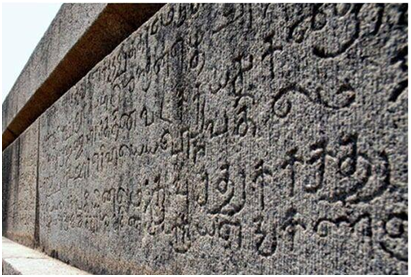Uttaramerur inscription
Context: Recently Prime Minister Narendra Modi referred to the Uttaramerur inscription in Kanchipuram, Tamil Nadu, while discussing India’s democratic history,
- While Uttaramerur has multiple inscriptions spanning centuries, the most famous one is from the reign of Parantaka I (907-953 AD). These provide a detailed description about the village’s self-governance and have been cited by historians and political leaders alike as evidence of India’s history of democratic functioning.
Where is Uttaramerur?
- Uttaramerur lies in present-day Kanchipuram district, approximately 90 km southeast of Chennai.
- it is a small town and had a population of roughly 25,000 in the census of 2011. It is known for its historic temples built during Pallava and Chola rule.
- The famous inscription from Parantaka I’s reign is found on the walls of the Vaikunda Perumal Temple.
What does the inscription say?
- The inscription gives details of the functioning of the local sabha, i.e. the village assembly.
- A sabha was an assembly exclusively of brahmans and had specialised committees tasked with different things.
- The Uttaramerur inscription details how members were selected, the required qualifications, their roles and responsibilities, and even the circumstances in which they could be removed.
Appointing representatives to the sabha
- There will be 30 wards. Everyone living in these 30 wards would assemble and select one representative for the village assembly.
- It then goes on to describe what the qualifications for such a representative must be.
- These include ownership of a certain amount of land, having a house, being between the age of 35 and 70 and “knowing mantras and Brahmanas” (from the Vedic corpus).
- An exception can be made on land ownership if the person has learnt at least “one Veda and four Bhashyas”. One must also be “well-versed in business” and “virtuous”.
- The inscription then lists a number of factors which disqualify someone and their family (all the relations are systematically listed) from consideration.
- These include, “not having submitted accounts” while previously serving in a committee, committing any of the first four of the five ‘great sins’ (killing a brahman, drinking alcohol, theft and adultery), being associated with outcastes, and eating ‘forbidden’ dishes.
- All those eligible and willing would write their names on palm leaf tickets following which, the representative would be chosen on the basis of an elaborate draw of lots, conducted by priests in the inner hall of the building where the assembly meets.
Detailing responsibilities
- The inscription describes a number of important committees within the sabha with their own distinct functions.
- These include, the garden committee, the tank committee, the annual committee (an executive committee which required prior experience and knowledge to be a part of), the committee for supervision of justice (for supervising appointments and wrong doing), the gold committee (in charge of all the gold in the village temple) and the five-fold committee (its role is unclear in the inscription).
- These committee assignments would last for 360 days after which the members would have to retire.
- Anyone in the committee who was implicated in any wrongdoing, such as forgery or having ridden a donkey (i.e. being punished for a crime), was removed instantly. Also, the inscription emphasises upon the keeping of accounts – any discrepancy can also disqualify members of the sabha.
Is this an example of a democracy?
- While the Uttaramerur inscription gives details of local self-governance, on closer inspection, it is far from a truly democratic system.
- Not only does it restrict sabha membership to a tiny subsection of land-owning brahmans, it also does not have true elections. Rather, it chooses members from the eligible pool of candidates through a draw of lots.
- That being said, this does not mean that this inscription should not be cited as a precedent for democratic functioning. The idea of a democracy, as understood today, is a fairly recent phenomenon. The United States, often hailed as the epitome of a liberal democracy, only gave universal adult franchise to its population in 1965.
What the Uttaramerur inscription details is a system of local self-government, outside the direct authority of the king. Furthermore, for all intents and purposes, the inscription is like a constitution – it describes both the responsibilities of members of the sabha as well as the limitations to the authority of these members. If the rule of law (rather than rule by personal diktat) is an essential component of a democracy, the Uttaramerur inscription describes a system of government which follows just that.
| Practice Question
1. Describe the importance of Uttaramerur inscription in democratic evolution of India? |




